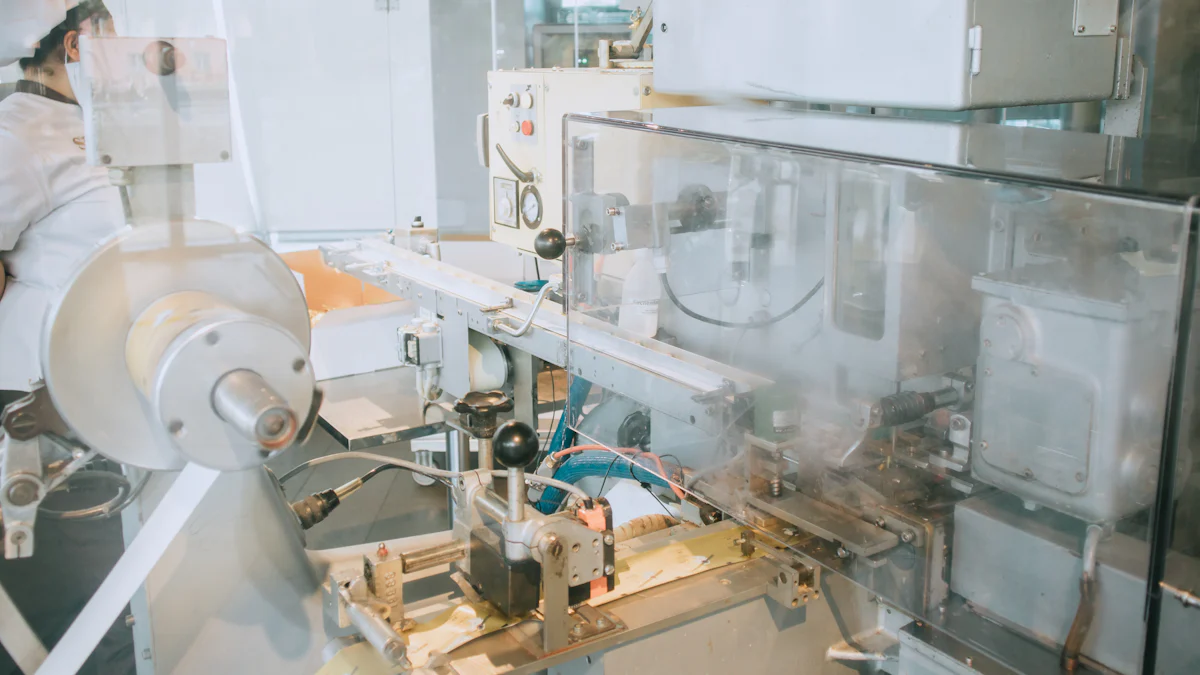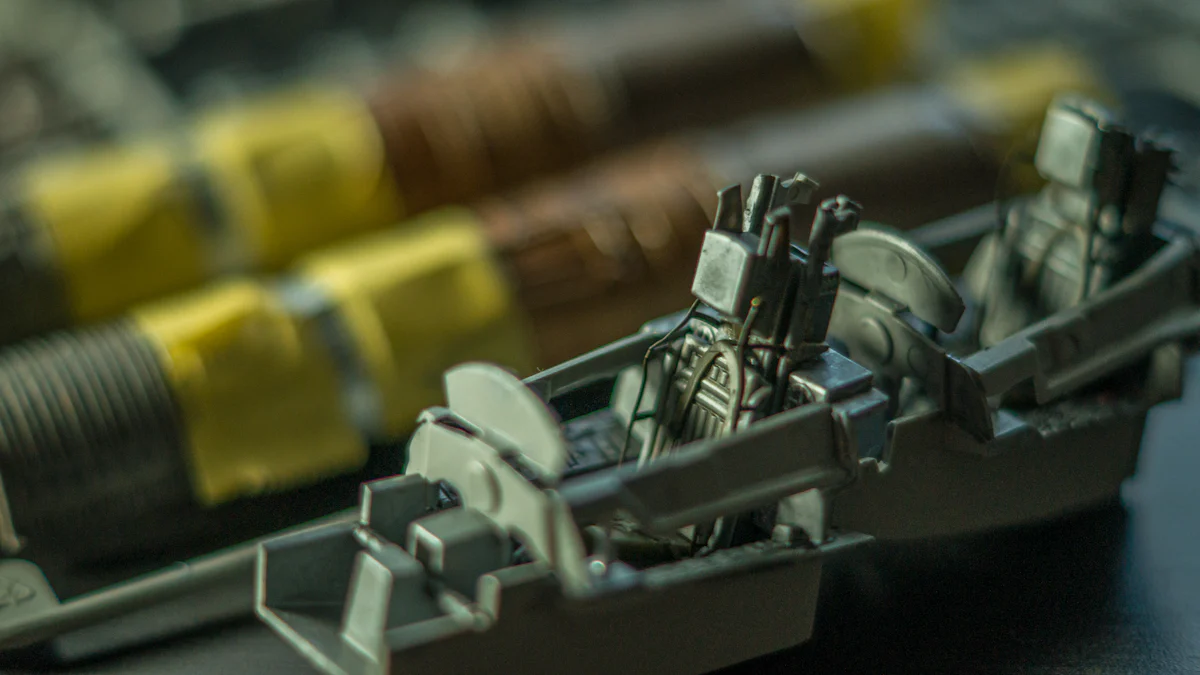What is an Injection Molding Machine and How Does it Work

An injection molding machine plays a vital role in modern manufacturing. Industries such as automotive, medical, and packaging rely on it to produce durable and precise components. From car bumpers to surgical tools, this technology ensures efficiency and quality. Its versatility makes it indispensable for creating complex parts across diverse applications.
Key Takeaways
- Injection molding machines help make strong and accurate parts for cars and healthcare tools.
- The process includes adding materials, melting them, shaping in molds, cooling, and removing the final items.
- Picking the right machine—hydraulic, electric, or hybrid—depends on the size of parts and how many are needed.
How an Injection Molding Machine Works
Material Feeding
The process begins with feeding raw materials into the injection molding machine. These materials, often in the form of pellets or granules, are loaded into a hopper. Common materials include polypropylene, ABS, and polycarbonate, each chosen based on the product’s requirements. For instance, polypropylene is ideal for lightweight and fatigue-resistant items, while ABS offers high impact resistance. The hopper ensures a steady supply of material to the machine’s barrel, where the next stage occurs.
Melting and Plasticizing
Inside the barrel, the raw material undergoes melting and plasticizing. This step uses external heating and the rotational motion of a screw to transform solid pellets into a uniform molten state. Reciprocating screw injection molding machines are widely used for this purpose due to their efficiency in mixing and melting. The combination of heat and shear forces ensures the material is evenly plasticized, ready for injection.
Injection into the Mold
Once plasticized, the molten material is injected into the mold. The screw pushes the material forward under high pressure, filling the mold cavities completely. Proper pressure settings are crucial; insufficient pressure can result in voids, while excessive pressure may cause defects like flashing. The mold’s design and the material’s flow properties influence the success of this step.
Cooling and Solidification
After injection, the material cools and solidifies within the mold. Cooling time depends on factors such as material type, wall thickness, and mold temperature. For example, thicker parts or materials with higher melting points require longer cooling times. This stage ensures the product retains its intended shape and structural integrity.
Ejection of the Finished Product
Once cooled, the finished product is ejected from the mold. Various mechanisms facilitate this, including ejector pins, sleeves, and air ejection systems. Ejector pins are cost-effective and commonly used, while air ejection provides a reliable, non-mechanical alternative. The ejection process must be precise to avoid damaging the product or mold.
Components of an Injection Molding Machine

Injection Unit
The injection unit plays a critical role in the operation of an injection molding machine. It is responsible for melting and injecting plastic into the mold. This unit consists of three main components:
- Hopper: Stores raw plastic material, such as pellets or granules, before feeding it into the machine.
- Barrel: Melts the plastic using heat and pressure, transforming it into a molten state.
- Screw: Rotates to push the molten plastic forward while mixing and homogenizing the material.
These components work together to ensure the plastic is evenly melted and ready for precise injection into the mold.
Clamping Unit
The clamping unit secures the mold during the injection process. It applies the necessary force to keep the mold closed, preventing leaks or defects. Key functions of this unit include:
- Opening and closing the mold.
- Ejecting the finished product after cooling.
- Holding the mold securely with two large clamping plates during injection.
This unit ensures the mold remains stable, enabling accurate and consistent production.
Mold
The mold determines the shape and features of the final product. Manufacturers construct molds using various materials based on cost and application. Common options include:
- Polyurethane: Affordable and suitable for flexible molds.
- Silicone: Versatile but more expensive.
- Epoxy Resins: Durable and widely applicable.
The mold’s design, including gate location and cooling channels, directly impacts the quality and precision of the molded parts.
Control System
The control system ensures precision and consistency throughout the injection molding process. It optimizes key parameters such as temperature, pressure, and speed to maintain material quality and avoid defects. Advanced systems, like those in electric machines, use servo motors for precise movement control. Proper maintenance of the mold and control system further enhances product consistency and reduces errors.
Types of Injection Molding Machines

Hydraulic Machines
Hydraulic injection molding machines rely on hydraulic cylinders to generate the force needed for the injection and clamping processes. These machines are well-suited for producing large and complex parts due to their high clamping force. Key characteristics include:
- High durability, ensuring reliable performance over extended production cycles.
- Greater energy consumption compared to newer technologies.
- Slower cycle times, which may reduce production efficiency.
Hydraulic systems provide the pressure required to inject molten plastic into the mold, ensuring proper shaping and sealing.
The hydraulic system must deliver consistent performance, even in continuous, all-weather production cycles.
Despite their higher energy usage, these machines offer a good return on investment due to their longevity and ability to handle demanding applications.
Electric Machines
Electric injection molding machines use independent motors to control each movement, offering significant advantages over hydraulic systems. These include:
- Energy efficiency, with power consumption reduced by 50–75%.
- Faster cycle times and higher precision, resulting in a more repeatable process.
- Cleaner operation, as they eliminate the risk of hydraulic oil leaks.
Electric machines also reduce scrap rates due to their tight precision and repeatability. Their energy savings, ranging from 30% to 70%, make them a cost-effective choice for manufacturers seeking sustainability and lower operating costs.
Hybrid Machines
Hybrid injection molding machines combine the strengths of hydraulic and electric systems. They use electric motors for precise movements and hydraulic power for high clamping force. This combination achieves a balance between energy efficiency and performance. Benefits include:
- Versatility for producing both small components and large parts.
- Maximized advantages of both electric and hydraulic systems.
- Improved energy efficiency without compromising on power.
These machines are ideal for manufacturers looking for a middle ground between the precision of electric machines and the robustness of hydraulic systems.
Practical Considerations for Injection Molding Machines
Machine Sizing and Selection
Choosing the right injection molding machine requires careful evaluation of project requirements. The clamping force, which depends on part size, material, and mold design, plays a critical role. Shot size, representing the maximum plastic volume injected per cycle, determines the machine’s capacity to handle specific parts.
To simplify the selection process:
- Define the project’s needs, including part dimensions, material, and production volume.
- Select the appropriate machine type—hydraulic, electric, or hybrid—based on performance and efficiency.
- Calculate the necessary clamp tonnage to ensure proper molding without defects.
- Match the injection unit’s specifications to the project’s requirements.
Manufacturers should also consider production volume and material compatibility. Hydraulic machines suit high-volume production, while electric or hybrid options excel in precision and energy efficiency for smaller runs.
Maintenance and Longevity
Proper maintenance ensures the longevity of an injection molding machine. Regular cleaning removes residues and prevents wear. Scheduled inspections help identify potential issues early, reducing downtime. Lubricating moving parts minimizes friction and extends component life.
Best practices include:
- Daily visual checks using a checklist.
- Weekly inspections of hoses and cylinders for leaks.
- Quarterly maintenance to verify power lines and overall functionality.
- Storing molds in clean, temperature-controlled environments to prevent damage.
Avoiding overuse by rotating molds evenly also reduces wear and tear. Implementing a structured maintenance program enhances machine reliability and performance.
Safety Protocols
Operating an injection molding machine requires strict adherence to safety protocols. Operators must follow standard procedures, such as opening and closing safety doors correctly. Manual operations should only occur after shutting down the oil pump and power supply.
Key safety measures include:
- Responding to alarms by switching to manual mode and evacuating the area.
- Using emergency stop buttons during unusual noises or injuries.
- Keeping the workspace free of oil or water to prevent accidents.
- Ensuring safety doors cut off power when opened.
- Communicating with team members before approaching the machine.
Regular safety checks and functional emergency systems create a secure working environment, reducing risks during operation.
Injection molding machines revolutionize modern manufacturing by enabling the efficient production of complex and precise parts. Their benefits include:
- Efficiency: Features are integrated directly into parts, reducing assembly needs.
- Cost-effectiveness: Minimal post-processing saves time and expenses.
- Design flexibility: Complex shapes and features are achievable.
- Sustainability: Energy-efficient machines lower operational costs and carbon footprints.
Advanced tooling and robotics enhance precision, ensuring consistent quality. These machines remain indispensable across industries like automotive and medical, where accuracy and reliability are paramount.
FAQ
What industries use injection molding machines?
Injection molding machines are widely used in automotive, medical, packaging, electronics, and consumer goods industries. They produce precise, durable, and complex components efficiently.
How long does the injection molding process take?
The process duration depends on part size, material, and cooling time. On average, it ranges from a few seconds to several minutes per cycle.
Can injection molding machines handle multiple materials?
Yes, some machines support multi-material molding. They combine different plastics or colors in a single product, enhancing design flexibility and functionality.